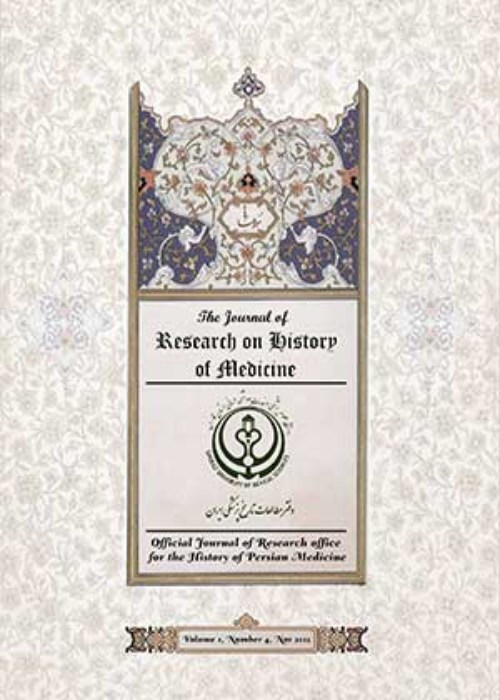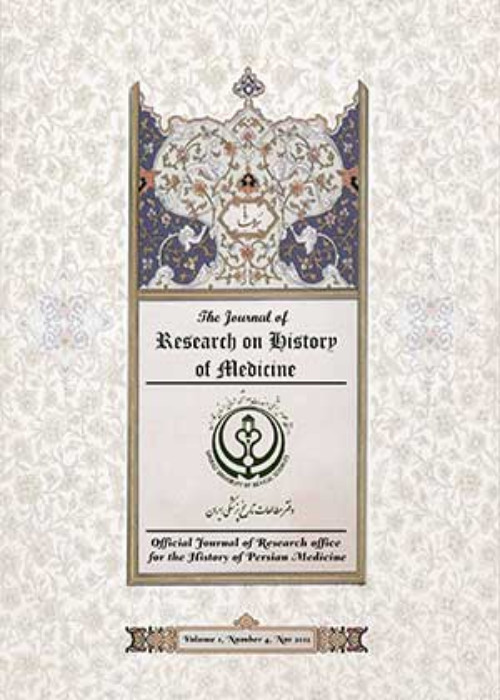فهرست مطالب

Journal of Research on History of Medicine
Volume:12 Issue: 2, May 2023
- تاریخ انتشار: 1402/02/11
- تعداد عناوین: 8
-
-
Pages 77-78
-
Pages 79-90In the Middle Persian text of selections of Zādispram, the stages of embryo development, frāz-waxšēnīdar Frawahr power (ether), and the three functions of “germinating,” “adding,” and “caring” create the way of caring for and nurturing the cellular environment. By creating a defense barrier, this power protects the cells against factors that reduce the cell reserve, including differentiation stimuli and apoptosis (programmed cell death) stimuli. The question raised in this research is that according to the stages of evolution (transformation), “how does Frawahr power guard and take care of the development stages of humans before birth and until death?” In other words, the present study aimed to investigate and analyze the theory of “development,” which explains that a cell contributes to the process and stages of embryo development and self-renewal by performing symmetrical division based on the draft and planning of the Frawahr power. The research method was descriptive-analytical, focusing on the attitude of Zādispram about concepts, such as embryo development and genesis. The findings revealed that the Frawahr power and the proliferation potential could prompt the accumulation of cell lines, including embryonic and bone marrow cells; accordingly, the embryonic body causes renewal in humans.Keywords: Selections of Zādispram, Frawahr, Embryo, Ether, apoptosis, Humans
-
Pages 91-98Jundishapur is one of the most important centers for transferring medical knowledge from Persian civilization to Islamic civilization. The studies of this hospital-university center in recent decades have gone through at least three different periods. The third round of Jundishapur studies focuses on new findings and lesser-known reports. The book Adab al-Tabib and its author reports on the ninth century AD about Jundishapur provides new information to researchers in this field that has not been reported so far. The author’s description of this book provides a new picture of the relationship between the Jundishapur Hospital-Training Center and Baghdad, which can be a good reflection of its management, and the transfer of physicians and researchers from Iran to the Center of Islamic Civilization. This information shows how, with the strengthening of Baghdad as a scientific center, Jundishapur slowly lost its importance, and doctors and researchers preferred to migrate to Baghdad for more income. This migration can be considered the second great scientific migration of Iranians in history.Keywords: Ishaq ibn Ali al-Ruhawi, Jundishapur, university, Persian medicine, Iranian people
-
Pages 99-112The history of medicine during the Safavid era (1736-1501 AD) was accompanied by changes; compared to previous periods, it had a lower position. However, the presence of prominent physicians who were famous in various scientific fields caused the knowledge of pharmacology and pharmaceutics to shine so much so that the period was known as the Golden Age of pharmaceutics. Mohammad Saeed Qomi was a physician, pharmacist, and philosopher of the Safavid era who remained unknown despite his fame and important texts. The present research, performed in a descriptive-analytical manner and relying on the resources of libraries, is an attempt to identify and introduce this physician’s medical texts and his scientific life. The findings of this study indicate that hakim Mohammad Saeed Qomi, holding the title of “the Little Sage”, was one of the thinkers of the tenth century AH. He was the private physician of Safavid Shah Abbas II (1632-1666 AD). He was brought up in a scholarly family, where medicine and writing poetry were hereditary. The surviving treatises of this anonymous physician show his knowledge and approach to medical science, pharmacy, and related fields, such as anatomy. Mohammad Saeed’s medical masterpiece is called “Anatomy of the Bones of the Head and Upper Jaw”, considered the first text in the field of anatomy in the Safavid era.Keywords: Safavid, Medicine, Mohammad Saeed Qomi, Anatomy, Pharmacist
-
Pages 113-132One of the causes of premature deaths in different parts of the world and Iran during the Qajar era was the spread of infectious diseases in the 19th century. Meanwhile, in general, Iran did not have favorable health conditions. Kermanshah, as one of the main highways in the west of the country, the gateway to Mesopotamia and the most important pilgrimage route of Shiite Iran, has been one of the busiest travel, commercial and pilgrimage routes, and hence, was exposed to the spread of various infectious disease The purpose of this research is to investigate the prevalence of infectious diseases in Kermanshah during the Qajar era and its effects on the population change and death. The research method is historical and descriptive-analytical; documentary methods have been used to collect the information. The results and achievements of the research showed that the outbreak of infectious diseases, especially cholera, plague, and typhoid, occurred many times in Kermanshah and was one of the important factors in the significant decrease in the population of this state. The results of this research have shown that the ignorance, illiteracy, and superstition, the low level of medical knowledge, the inappropriate and insecure roads, the poor performance of the king and the local rulers in making appropriate decisions to prevent the spread of such diseases, had a significant impact on the extent of the casualties and the population decline.Keywords: Communicable diseases, Cholera, Population decline, Qajar, Kermanshah, Iran, History of medicine
-
Pages 133-144Unani medicine is one of the oldest systems encompassing the medical traditions from the Babylonian and Egyptian eras to the present Indian Unani tradition and Traditional Iranian medicine. It came to the Greeks through Egyptian civilization and was refined into a rational system by Hippocrates, Galen, Razi, and Avicenna. The faithful translation of traditional practices into Arabic in the medieval era under a comprehensive frame based on logic and observations developed the research concept methodology much earlier, which was believed to be a modern concept. The present paper reviews the changing face of research methods adopted in Unani medicine.The research concept was looked upon in the classical Unani literature. Several papers in this regard were also searched using search engines, namely PubMed, google scholar, and Science Direct.The concept of research methodology is quite primitive and has undergone several transitions throughout development and advancement in science. The shift from rational to evidence-based science is quite evident from the history of research development.Keywords: Logic, Observation, Scientific methodologies, Unani Medicine


